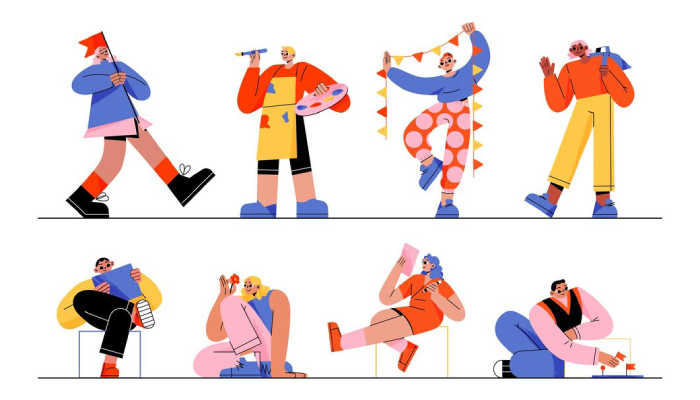
The Arts and Crafts Movement: Unraveling a Handmade History and Its Contemporary Revival
When people talk about “arts and crafts,” they often think of making fun things with paper, crayons, and glue, like what you might do in school. But did you know that “Arts and Crafts” is also a fancy term for a special style of art and design from a long time ago?
Back then, some really talented artists and designers made things in a certain way called the Arts and Crafts movement. They believed in making things by hand and using high-quality materials. It was like a rebellion against mass-produced stuff and a celebration of artistry.
Even though we live in a world of machines and digital technology today, some people still love the Arts and Crafts style. They appreciate the beauty of handmade items and the care that goes into making them.
If you’re interested in trying out this iconic style, it’s all about implementing craftsmanship and using natural materials to create unique and beautiful things. So, grab some supplies and let your creativity flow!
What is Arts and Crafts?
Arts and Crafts was an impressive way of making things that became popular around the 1900s. It was all about bringing back old-fashioned techniques in art and design. The term “Arts and Crafts” was discovered in 1887 when a group called the Arts and Crafts Exhibition Society started in London, but people had been doing this style for a while before that.
So, what did Arts and Crafts look like? Well, it covered a lot of different things like buildings, furniture, fabrics, pottery, and even things made of metal and glass. Basically, anything that could be made by hand can be considered as arts and crafts.
The cool thing about Arts and Crafts is that it didn’t have a strict set of rules. Artists and designers could put their own spin on it, so you’d see lots of different styles. But there were some things that most Arts and Crafts pieces had in common, like a focus on craftsmanship and using natural materials.
Characteristics of Arts and Crafts
- Emphasis on craftsmanship
- Use of natural materials
- Simple and functional design
- Integration of the arts
- Social and political ideals
Difference between Art Nouveau and Arts and Crafts
Art Nouveau and Arts and Crafts were two cool styles of art and design from a long time ago, and they were pretty similar in some ways. They both liked using aesthetic arches, flowery patterns, and beautiful stained glass. And guess what? Many of the same people who were big names in Arts and Crafts also helped start the Art Nouveau trend.
But even though they had a lot in common, there was one big difference between them. Art Nouveau was all about looking forward to the future. That’s why it’s called “New Art.” It took the old-fashioned vines and stuff from Arts and Crafts but made them look more modern and abstract with fancy lines.
Another thing is that Art Nouveau wasn’t afraid of using technology. It wanted to mix fine art and design together. Unlike Arts and Crafts, which didn’t like mass-produced stuff, Art Nouveau wanted everyone to enjoy art, whether they were rich or not. It found beauty in everything, from nature to things made in factories.
The Arts and Crafts Movement
In 1851, London hosted the first ever world fair called the Great Exhibition. It showcased decorative items from all over the world. However, many designers who went there didn’t like what they saw. They thought the items were made too quickly, focused too much on decorations without real meaning, and didn’t care about the materials. They blamed this poor quality on the fact that things were being made in large numbers by machines.
One of the people who went to the exhibition was William Morris, a British writer and designer. Today, many people see him as the father of the Arts and Crafts movement. Morris was deeply influenced by the ideas of philosopher John Ruskin and later by Karl Marx. He believed that making things in factories made workers feel disconnected from their creations. Morris loved art from the time before factories, especially Medieval art, which celebrated nature. In 1861, he and his friends started a company called Morris & Co. They worked on buildings, furniture, textiles, and glassware, and they were famous for making wallpaper with flower designs that looked like they came from old manuscripts.
Morris & Co really cared about using natural stuff and making things by hand. They wanted workers to be part of the whole design process from start to finish. Their designs became very popular and were often shown at the Arts and Crafts Exhibition Society, which helped shape the movement.
As Morris & Co became more famous, groups called guilds started to form all over the UK, similar to old-timey trade groups. These guilds let craftspeople, not just business owners, decide on the quality and price of the work. Some well-known groups from that time are the Century Guild of Artists, Home Arts and Industries Association, and the Art Workers Guild. In 1893, a magazine called The Studio came out and had a big impact on Arts and Crafts and also on Art Nouveau.
The Arts and Crafts movement then spread to the US, fitting well with the Progressive Era’s social reform ideas. It was especially appealing to women fighting for the right to vote. In Boston, Paul Revere Pottery, and in New Orleans, Newcomb Pottery were businesses run by women. They focused on creating Arts and Crafts ceramics and on teaching a trade to women, many of whom were immigrants. Julia Morgan, the first woman to become a licensed architect in California, became a key figure during this time. She designed over 700 buildings, including the famous Hearst Castle.
American designers liked the British Arts and Crafts style but they changed it a bit. They used machines to make simpler versions of these artsy items so they could sell more to people.
The Arts and Crafts movement was really popular for a while but started to fade away in the 1920s because of new styles like Art Deco and modernism. The movement wanted to go back to old ways of making things by hand, which was nice but ended up being too slow and expensive for the fast-paced 20th century. The items became too costly, which wasn’t what they originally wanted.
Even though the Arts and Crafts movement didn’t last forever, it influenced other art styles. It helped start the Mingei style in Japan in the 1920s and inspired the Bauhaus school, which thought a lot about how things are made, how they look, and what they’re made of.
Arrival of Graphic Design in Arts and Crafts
A hundred years later, the Arts and Crafts style is becoming popular again, but this time in graphic design. Even though we don’t use the big machines from the Industrial Revolution much anymore, we now have computers and software that can make a lot of designs really fast. But many of these designs don’t feel special, they seem boring and without much heart. That’s why some designers are looking back at old styles to make their work feel more unique and hand-made.
Modern Arts and Crafts in graphic design takes ideas from the past, especially from Medieval art. So, the new designs might include things like angels, the look of stained glass, or symbols from nature, all updated to fit with today’s brands.
Nature designs, like the ones you’d find in Morris & Co. wallpapers with leaves and flowers, are really popular in the new Arts and Crafts graphic design. They’re often used to decorate around words or a main picture, making everything look more interesting.
But the new Arts and Crafts style isn’t just about drawing plants or old-fashioned pictures. It also changes how letters look by adding fancy touches, like curls and swirls that remind us of hand-drawn letters from long ago. Sometimes, these fancy parts stand out in a letter that’s mostly plain, which makes it look really cool and different.
The most important part of Arts and Crafts is how it’s made. Even if a design is done on a computer, it shouldn’t look like it was. It’s supposed to feel like it was made by hand, with a special touch. Designers use techniques that make it look like they used pencils or paint, with lots of detailed lines and textures. Even though they’re working in the digital age, the idea is to make things look like they were crafted by hand, maybe even starting with real hand-drawn designs before they finish them on the computer.
Don’t just design, craft it
The Arts and Crafts movement was all about making things beautiful again. It didn’t like how machines during the industrial times made art and products look bad and feel less special for both the people making them and the people buying them. To fix this, it turned back to older styles from before all these machines, but the main point wasn’t just about how things looked. It was really about the spirit behind making things. To be part of Arts and Crafts, you need to be ready to really get involved, to care deeply about the materials you use and how your creations are useful. Arts and Crafts isn’t just about simple crafts like using glue and sticks, it’s about putting your heart into your designs.
If you’re looking for someone to create a really cool logo for your business, check out Logoleagues. They’re experts at crafting awesome designs that’ll catch your clients’ attention and make your brand stand out.




